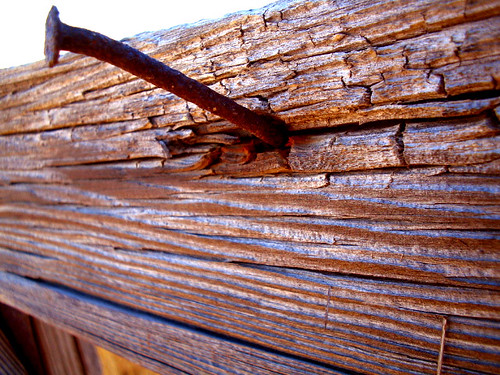
That rusty nail may look useless, but it's a helpful reminder of opportunity cost - also known to many writers as the Stephen King method of rejection management.
Every once in a while, I check on my virtual stack of rejections. It makes me want to hurl. But there's reason to conquer the fear. My stories need readers or they're dead on the page.
Then I take the next step and submit my work.
It's hard. So hard, I think I'll go through the process in second person. This way anyone can feel the sting, and I'll create some distance for the sake of (less painful) objectivity.
1. Research. Fall for an uber agent (who shall remain anonymous) because her bio looks sooo perfect online. Her blog? Genius. And she reps stories like yours.
2. Imagine a couple of top shelf editors who might fight over your story. (Martha Mihalik? Mallory Kass?) The phrases good deal and sold at auction haunt you.
3. Dream in deckle-edged pages, create a luscious cover. (Who are we kidding? You did that when you came up with the title.) Even go so far as to think up who might star in the screenplay. (Blame the blogger friends for THAT idea.)
4. Cry. Everything comes crashing down with a trite rejection letter. Heck. Even helpful rejections are painful to read. The rejection on a full? Bad. The rejection on a revision? Prefer not to go there.
5. Begin to understand Stephen King and his attic collection of rejections. (Too bad you can't tack yours up with a rusty nail. Email is slippery that way.)
6. Come to the concept of utility. Remember the pain? Ask an author if it ever ends. Learn: when you get numb to the pain, you've stopped growing. (see also - a thousand other cliches about pain.)
7. Dig deeper. With every rejection, challenge yourself to do better. Find a good workshop, interview a character, tweak some pages. Maybe even start a whole new story.
8. Return to step number one.
The process is so painful, I often stop doing it altogether and hide myself away in revisions instead. Yet each time I go through the motions of submission, my writing becomes a little bit stronger.
I'm finally at the stage where an author (who critiqued a recent first chapter) admired my sentences. I'm ecstatic because- after the plot looks good, and the characters are coming together -the sentences are what makes my writing mine. It's my voice. (Someone likes my VOICE!)
I just have to get up enough confidence to submit the stuff. And find an agent who likes my voice too. It might take me two more years, or ten, but this year I'm getting out of my own way. Here I go.
Ouch!
Stubbed my toe. ;)
The 2013 Plan:
BURNT AMBER: Five submissions out at a time, until I run out of agents/publishers.
MIST OF KAVALA: Two chapter revisions per week. Completion date: May
Don't know this method? Read Stephen King's memoir, On Writing, for some great perspective on a writer's life, and more on how to manage rejections with a nail in the attic.

